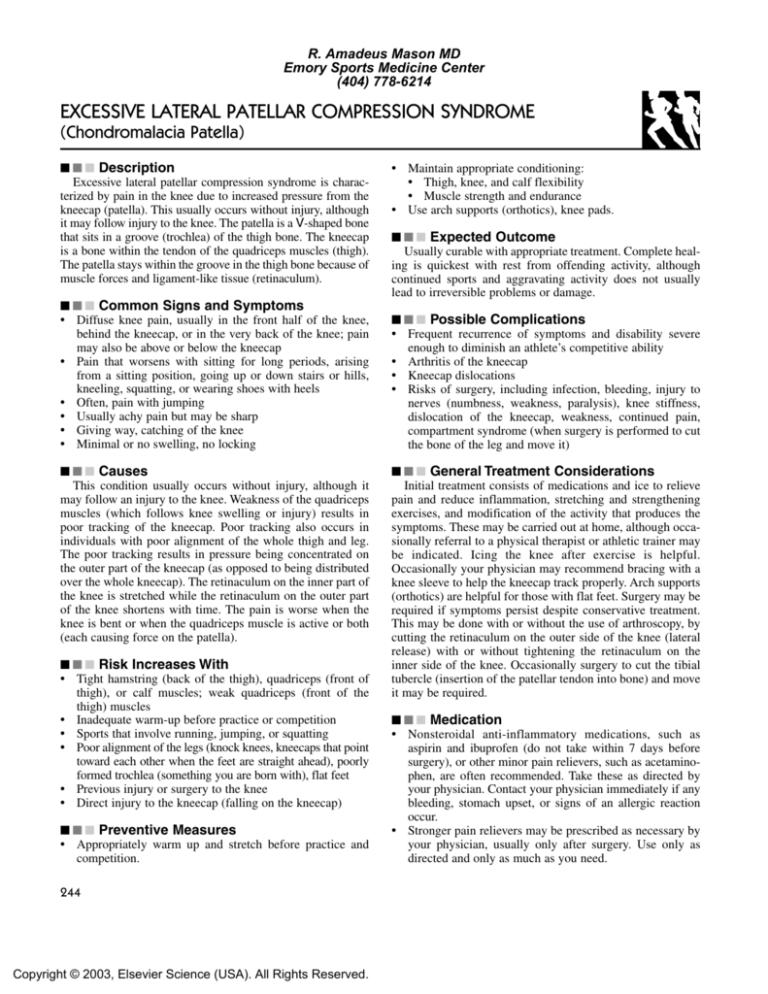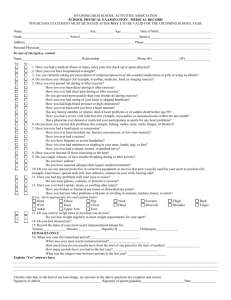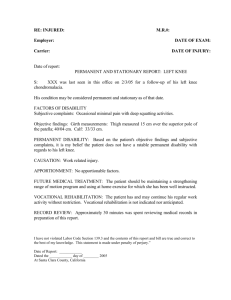
R. Amadeus Mason MD
Emory Sports Medicine Center
(404) 778-6214
EXCESSIVE LATERAL PATELLAR COMPRESSION SYNDROME
(Chondromalacia Patella)
■ ■ ■ Description
Excessive lateral patellar compression syndrome is characterized by pain in the knee due to increased pressure from the
kneecap (patella). This usually occurs without injury, although
it may follow injury to the knee. The patella is a V-shaped bone
that sits in a groove (trochlea) of the thigh bone. The kneecap
is a bone within the tendon of the quadriceps muscles (thigh).
The patella stays within the groove in the thigh bone because of
muscle forces and ligament-like tissue (retinaculum).
■ ■ ■ Common Signs and Symptoms
• Diffuse knee pain, usually in the front half of the knee,
behind the kneecap, or in the very back of the knee; pain
may also be above or below the kneecap
• Pain that worsens with sitting for long periods, arising
from a sitting position, going up or down stairs or hills,
kneeling, squatting, or wearing shoes with heels
• Often, pain with jumping
• Usually achy pain but may be sharp
• Giving way, catching of the knee
• Minimal or no swelling, no locking
■ ■ ■ Causes
This condition usually occurs without injury, although it
may follow an injury to the knee. Weakness of the quadriceps
muscles (which follows knee swelling or injury) results in
poor tracking of the kneecap. Poor tracking also occurs in
individuals with poor alignment of the whole thigh and leg.
The poor tracking results in pressure being concentrated on
the outer part of the kneecap (as opposed to being distributed
over the whole kneecap). The retinaculum on the inner part of
the knee is stretched while the retinaculum on the outer part
of the knee shortens with time. The pain is worse when the
knee is bent or when the quadriceps muscle is active or both
(each causing force on the patella).
■ ■ ■ Risk Increases With
• Tight hamstring (back of the thigh), quadriceps (front of
thigh), or calf muscles; weak quadriceps (front of the
thigh) muscles
• Inadequate warm-up before practice or competition
• Sports that involve running, jumping, or squatting
• Poor alignment of the legs (knock knees, kneecaps that point
toward each other when the feet are straight ahead), poorly
formed trochlea (something you are born with), flat feet
• Previous injury or surgery to the knee
• Direct injury to the kneecap (falling on the kneecap)
■ ■ ■ Preventive Measures
• Appropriately warm up and stretch before practice and
competition.
244
Copyright © 2003, Elsevier Science (USA). All Rights Reserved.
• Maintain appropriate conditioning:
• Thigh, knee, and calf flexibility
• Muscle strength and endurance
• Use arch supports (orthotics), knee pads.
■ ■ ■ Expected Outcome
Usually curable with appropriate treatment. Complete healing is quickest with rest from offending activity, although
continued sports and aggravating activity does not usually
lead to irreversible problems or damage.
■ ■ ■ Possible Complications
• Frequent recurrence of symptoms and disability severe
enough to diminish an athlete’s competitive ability
• Arthritis of the kneecap
• Kneecap dislocations
• Risks of surgery, including infection, bleeding, injury to
nerves (numbness, weakness, paralysis), knee stiffness,
dislocation of the kneecap, weakness, continued pain,
compartment syndrome (when surgery is performed to cut
the bone of the leg and move it)
■ ■ ■ General Treatment Considerations
Initial treatment consists of medications and ice to relieve
pain and reduce inflammation, stretching and strengthening
exercises, and modification of the activity that produces the
symptoms. These may be carried out at home, although occasionally referral to a physical therapist or athletic trainer may
be indicated. Icing the knee after exercise is helpful.
Occasionally your physician may recommend bracing with a
knee sleeve to help the kneecap track properly. Arch supports
(orthotics) are helpful for those with flat feet. Surgery may be
required if symptoms persist despite conservative treatment.
This may be done with or without the use of arthroscopy, by
cutting the retinaculum on the outer side of the knee (lateral
release) with or without tightening the retinaculum on the
inner side of the knee. Occasionally surgery to cut the tibial
tubercle (insertion of the patellar tendon into bone) and move
it may be required.
■ ■ ■ Medication
• Nonsteroidal anti-inflammatory medications, such as
aspirin and ibuprofen (do not take within 7 days before
surgery), or other minor pain relievers, such as acetaminophen, are often recommended. Take these as directed by
your physician. Contact your physician immediately if any
bleeding, stomach upset, or signs of an allergic reaction
occur.
• Stronger pain relievers may be prescribed as necessary by
your physician, usually only after surgery. Use only as
directed and only as much as you need.
R. Amadeus Mason MD
Emory Sports Medicine Center
(404) 778-6214
EXCESSIVE LATERAL PATELLAR COMPRESSION SYNDROME
• Injections of corticosteroids may uncommonly be given to
reduce inflammation.
■ ■ ■ Heat and Cold
• Cold is used to relieve pain and reduce inflammation for
acute and chronic cases. Cold should be applied for 10 to
15 minutes every 2 to 3 hours for inflammation and pain
and immediately after any activity that aggravates your
symptoms. Use ice packs or an ice massage.
• Use heat before performing stretching and strengthening
activities prescribed by your physician or physical therapist. Use a heat pack or a warm soak.
■ ■ ■ Notify Our Office If
• Symptoms get worse or do not improve in 6 to 8 weeks
despite treatment
• Any of the following occur after surgery:
245
• Pain, numbness, coldness, or discoloration (blue, gray,
or dusky) in the foot
• Fever, increased pain, swelling, redness, drainage, or
bleeding in the surgical area
• New, unexplained symptoms develop (drugs used in treatment may produce side effects)
Tilted
patella
Forces evenly distributed
Forces distorted and concentrated
Figure 1
From Scuderi GR, McCann PD, Bruno PJ: Sports Medicine:
Principles of Primary Care. St. Louis, Mosby, 1997, p. 368.
EXERCISES
➢ RANGE OF MOTION AND STRETCHING
EXERCISES • Excessive Lateral Patellar
Compression Syndrome
These are some of the initial exercises you may start
your rehabilitation program with until you see your
physician, physical therapist, or athletic trainer again
or until your symptoms are resolved. If any of these
exercises causes pain or discomfort stop them and
consult your physician, physical therapist, or athletic
trainer. Please remember:
• Flexible tissue is more tolerant of the stresses
placed on it during activities.
• Each stretch should be held for 20 to 30 seconds.
• A gentle stretching sensation should be felt.
Copyright © 2003, Elsevier Science (USA). All Rights Reserved.
PATELLA • Self Mobilization, Knee Flexed
1. Sit with your knee bent 75 to 90 degrees and your foot flat
on the floor.
2. Place the inside half of your palm (near your thumb) on
top of the inside half of your kneecap.
3. Press down on the inside half of your kneecap, attempting
to lift the outside edge up, stretching the fibers that are
tight. You should feel a slight stretching sensation on the
outside edge of your kneecap.
4. Hold this position for
seconds.
5. Repeat exercise
times,
times per day.
246
R. Amadeus Mason MD
Emory Sports Medicine Center
(404) 778-6214
A
B
C
FLEXIBILITY • Hamstrings, Ballet
1. Stand and prop the leg you are stretching on a chair, table,
or other stable object.
2. Place both hands on the outside of the leg you are
stretching.
3. Make sure that your hips/pelvis are also facing the leg you
are stretching.
4. Slide your hands down the outside of your leg.
5. Lead with your chest/breast bone. Keep your chest upright
and back straight. Do not hunch over at the shoulders.
Keep your toes pointing up.
6. You should feel a stretch in the back of your thigh.
7. Hold this position for
seconds.
8. Repeat exercise
times,
times per day.
STRETCH • Quadriceps, Prone
1. Lie on your stomach as shown.
2. Bend your knee, grasping your toes, foot, or ankle. If you
are too “tight” to do this, loop a belt or towel around your
ankle and grasp that.
3. Pull your heel toward your buttock until you feel a stretching sensation in the front of your thigh.
4. Keep your knees together.
5. Hold this position for
seconds.
6. Repeat exercise
times,
times per day.
Copyright © 2003, Elsevier Science (USA). All Rights Reserved.
D
ILIOTIBIAL BAND STRETCH
1. Lie on your side as shown. The muscle/iliotibial band to be
stretched should be on top.
2. With your hand, grasp your ankle and pull your heel to
your buttocks and bend your hip so that your knee is pointing forward as in the top drawing (A).
3. Rotate your hip up so that your thigh is away from your
body as shown and in line with your body. Keep your heel
to your buttocks (B).
4. Bring the thigh back down and behind your body. Do
not bend at the waist. Keep your heel pressed to your
buttocks (C).
5. Place the heel of your opposite foot on top of your knee
and pull the knee/thigh down farther. You should feel a
stretch on the outside of your thigh near your kneecap (D).
6. Hold this position for
seconds.
7. Repeat exercise
times,
times per day.
R. Amadeus Mason MD
Emory Sports Medicine Center
(404) 778-6214
EXCESSIVE LATERAL PATELLAR COMPRESSION SYNDROME
247
➢ STRENGTHENING EXERCISES • Excessive
Lateral Patellar Compression Syndrome
These are some of the initial exercises you may start
your rehabilitation program with until you see your
physician, physical therapist, or athletic trainer again
or until your symptoms are resolved. Please remember:
• Strong muscles with good endurance tolerate stress
better.
• Do the exercises as initially prescribed by your physician, physical therapist, or athletic trainer. Progress
slowly with each exercise, gradually increasing the
number of repetitions and weight used under their
guidance.
• Only do your exercises in a pain-free range of
motion. If the exercises that involve bending your
knees while bearing weight cause pain, stop them
and consult your physician, physical therapist, or
athletic trainer.
STRENGTH • Quadriceps, Isometrics
1. Lie flat or sit with your leg straight.
2. Tighten the muscle in the front of your thigh as much as
you can, pushing the back of your knee flat against the
floor. This will pull your kneecap up your thigh, toward
your hip.
3. Hold the muscle tight for
seconds.
4. Repeat this exercise
times,
times per day.
Copyright © 2003, Elsevier Science (USA). All Rights Reserved.
STRENGTH • Quadriceps, Short Arcs
1. Lie flat or sit with your leg straight.
2. Place a
inch roll under your knee, allowing it to
bend.
3. Tighten the muscle in the front of your knee as much as
you can, and lift your heel off the floor.
4. Hold this position for
seconds.
5. Repeat exercise
times,
times per day.
Additional Weights: OK TO USE
DO NOT USE!!!
If okay’d by your physician, physical therapist, or athletic
trainer, a
pound weight may be placed around your
ankle for additional weight.
STRENGTH • Quadriceps, 7 Count
The quality of the muscle contraction in this exercise is
what counts the most, not just the ability to lift your leg!
1. Tighten the muscle in front of your thigh as much as you
can, pushing the back of your knee flat against the floor.
2. Tighten this muscle harder.
3. Lift your leg/heel 4 to 6 inches off the floor.
4. Tighten this muscle harder again.
5. Lower your leg/heel back to the floor. Keep the muscle in
front of your thigh as tight as possible.
6. Tighten this muscle harder again.
7. Relax.
8. Repeat exercise
times,
times per day.
248
R. Amadeus Mason MD
Emory Sports Medicine Center
(404) 778-6214
STRENGTH • Quadriceps, Step-Ups
1. Use a step or books.
2. Place your foot on the step or books approximately
inches in height. Make sure that your kneecap is in line
with the tip of your shoe or your second toe.
3. Hold on to a hand rail, chair, wall, or another object for
balance if needed.
4. Slowly step up and down. Make sure that the kneecap is
always in line with the tip of your shoe or your second toe.
Lightly touch the heel of the opposite leg to the floor and
return to the starting position.
5. Repeat exercise
times,
times per day.
STRENGTH • Quadriceps, Wall Slide
1. Stand with your back against the wall. Your feet should be
shoulder-width apart and approximately 18 to 24 inches
away from the wall. Your kneecaps should be in line with
the tip of your shoes or your second toe.
2. Slowly slide down the wall so that there is a
degree
bend in your knees. (Your physician, physical therapist,
or athletic trainer will instruct you how to progress the
amount of bend based on your symptoms and diagnosis.)
3. Hold this position for
seconds. Stand up and rest
for
seconds.
4. Repeat exercise
times,
times per day.
Copyright © 2003, Elsevier Science (USA). All Rights Reserved.
STRENGTH • Quads
1. Stand with your feet shoulder-width apart and place equal
weight on both legs.
2. Keep your kneecaps in line with your toes.
3. Slowly bend both knees, keeping equal weight on both
legs, and return to a standing position.
4. Do not bend your knees more than 90 degrees.
5. You may use the edge of a table or counter for balance if
needed.
6. Repeat exercise _____ times, _____ times per day.
STRENGTH • Quads
1. Stand on the edge of a step/stair. Make sure your kneecap
is in line with your second toe.
2. Slowly step down and touch the heel of your opposite leg
on the stair below you. Return to the starting position.
3. Do not go into a painful range. Stop short of the step if
necessary to avoid any pain.
4. Use your stair rails for balance as needed.
5. Repeat exercise
times,
times per day.
R. Amadeus Mason MD
Emory Sports Medicine Center
(404) 778-6214
EXCESSIVE LATERAL PATELLAR COMPRESSION SYNDROME
STRENGTH • Isometric Quad/VMO
1. Sit in a chair with your knee bent 75 to 90 degrees as
shown in the drawing.
2. With your fingertips, feel the muscle just above the
kneecap on the inside half of your thigh. This is the VMO.
3. Push your foot and leg into the floor to cause the thigh
muscles to tighten.
4. Concentrate on feeling the VMO tighten. This muscle is
important because it helps control the position of your
kneecap.
5. Tighten and hold for
seconds.
6. Repeat exercise
times,
times per day.
Copyright © 2003, Elsevier Science (USA). All Rights Reserved.
249
R. Amadeus Mason MD
Emory Sports Medicine Center
(404) 778-6214
Notes:
Notes and suggestions
Copyright © 2003, Elsevier Science (USA). All Rights Reserved.
(Up to 4400 characters only)




